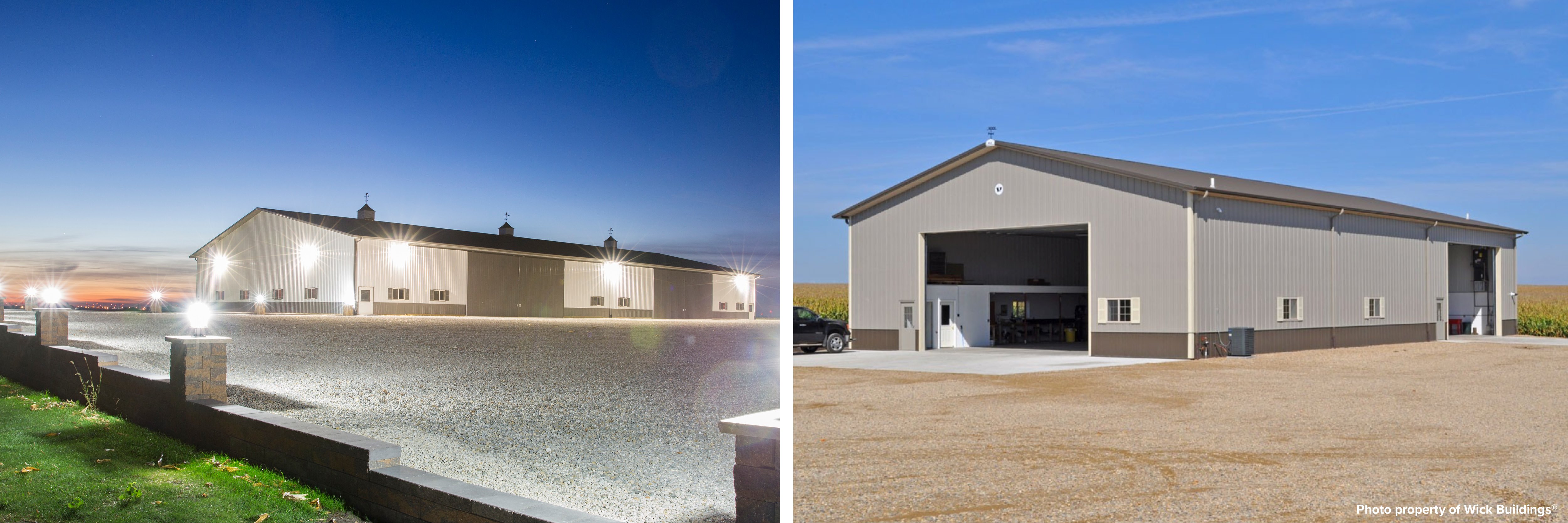Posts | Building Tips | Comparisons
FBi Buildings vs Wick: Who's Best for Your Project?
Angie joined FBi Buildings in 2012 and is now the Director of Marketing. She's an avid reader and enjoys outdoor leisure and cheering on her two daughters at their sporting events.
Our builder comparison for this week features Wick Buildings.
Like FBi, Wick constructs buildings for ag, commercial, residential and equine facilities. They’re firmly committed to the strength and longevity of their post-frame buildings, which will endure the test of time.
In this blog, we will present each builder's facts and strengths. Our goal is to help you better understand how FBi compares to Wick before you make a final decision.
FBi Buildings vs Wick Buildings: 7 Key Differences to Look For
1. Customer Service
FBi Buildings
 From the first call into the office all the way to the last call with your Project Manager, FBi tries to ensure that you’re aware of what’s going on with your post-frame building project every step of the way.
From the first call into the office all the way to the last call with your Project Manager, FBi tries to ensure that you’re aware of what’s going on with your post-frame building project every step of the way.
Each customer is assigned their own personal Project Sales Consultant who lives in their area. FBi currently has 30+ Project Sales Consultants spread throughout Illinois and Indiana, covering designated territories. This allows them to meet with you not only to understand your needs in person but also to walk your property and help you identify the best location for your building.
Once the project is finalized and you’re ready for construction to start, you will be given a personal Project Manager. They are responsible for the scheduling of FBi’s crews, along with providing resources to help check your site prep or answer other questions you might have.
FBi’s Project Managers help outline your project in four specific phases:
- Processing: Is an overview of the first steps to your construction project. This is also where FBi will be going over site preparation, permitting, and approximate start time.
- Design & Permit: FBi will follow up with you about your building permits and site prep updates. Your Project Manager will also be reviewing your construction drawings and validating the expected construction start date.
- Pre-Mobilization: Involves your Project Manager in completing the steps to set up the date the crew and material will arrive.
- Construction: This phase details the main milestones that will happen during construction that you need to be aware of along with the finishing steps after completion.
Wick Buildings
Wick’s approach is slightly different from FBi’s. Instead of having a dedicated salesman for your project, they have District Sales Managers in charge of the states they serve. That person is responsible for finding dealers to construct their buildings, also known as Wick Dealers.
You essentially have two options if you choose Wick:
- You can work with a Wick Dealer who provides the material, and the dealer’s crews will construct your post-frame building
- Or, you can purchase a Wick-constructed building, and Wick’s crew will be responsible for the construction
Instead of having Project Managers, Wick has a team of Operation Managers. This person is responsible for the delivery of materials and scheduling of the crews (if you choose a Wick-constructed building). However, if you work with a Wick Dealer, then the dealer will handle all of the scheduling and coordinating of material delivery.
Who has the best customer service?
FBi comes out on top for this one because their Project Managers (PM) are able to spend all their time on sold contracts and assisting you through your entire construction process. By having a dedicated PM, you’re more likely to get your questions (or concerns) answered in a timely fashion.
In contrast, Wick’s dealers are still tasked with selling other projects. This can be harder to get projects completed due to their multiple roles.
Both companies will offer you assistance throughout the entire construction process, but with two totally different approaches.

2. Service Area
FBi Buildings
FBi is a family-owned company that started in 1958. Their corporate headquarters is located in Remington, Indiana. During that time, they’ve been known as the preferred pole barn builder in the Midwest.
Currently, their service area is Indiana and Illinois, as well as select counties of Michigan, Missouri, and Ohio.
In 2025, FBi Buildings expanded our Iowa presence by acquiring Eastern Iowa Building, a trusted company with 20+ years of post-frame experience.
Wick Buildings
Wick Buildings is a privately held company that started in 1954. The headquarters for Wick is located 25 miles west of Madison in Mazomanie, Wisconsin.
Currently, their service area covers the Midwest, Great Lakes, and Great Plains Region. They construct pole barns in the following 16 states:
- Colorado
- Illinois
- Indiana
- Iowa
- Kansas
- Kentucky
- Michigan
- Minnesota
- Missouri
- Nebraska
- North Dakota
- Oklahoma
- South Dakota
- Wisconsin
- Wyoming
Who has the best service area?
Wick easily wins this. With coverage in 16 states, spread across the Midwest, Great Lakes, and Great Plains regions, they are able to service a greater region than FBi Buildings.

3. Pole Barn Materials
Steel
FBi Buildings
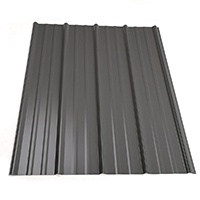 FBi’s panels are 29 gauge, heat-treated, full-hard, high-tensile steel with a minimum yield point of 80,000 PSI (pounds per square inch). That’s 60 - 78% higher than what’s commonly used.
FBi’s panels are 29 gauge, heat-treated, full-hard, high-tensile steel with a minimum yield point of 80,000 PSI (pounds per square inch). That’s 60 - 78% higher than what’s commonly used.
A high yield is nearly twice as strong as other steel and can improve the structural integrity of your building by providing greater resistance to impact damage from hail, rocks, etc.
Their buildings also feature galvalume walls and roofs. Depending on what pole barn color you choose, FBi will also use galvanized steel panels on their walls.
Galvalume is a combination of aluminum, silicon, and zinc coating that fights corrosion. This is different from galvanized steel where once their galvanized coatings wear down or are penetrated, corrosion will begin to spread.
Wick Buildings
Unlike FBi, Wick roll forms its own steel at their factory. Their steel panels are 29 gauge, full-hard, 82,000 PSI hardness or better. Their panels are twice as impact resistant as 30,000 PSI commercial-grade steel.
With Wick, their exterior steel is G-90 galvanized. If you compare G-90 to G-60 (non-structural commercial quality steel), you’ll get 50% more corrosion protection.
Who has the best steel?
This one comes out a tie. Both companies use 29-gauge steel, but with different variances of pounds per square inch. They also both incorporate galvalume and galvanized steel for their roof and wall panels. FBi’s galvanized steel is G100 and Wick’s is G90. G100 is known to be thicker than G90 steel. However, Wick does have one advantage over FBi by roll forming their own steel.

Watch the video below to see how FBi’s steel compares when put under the typical pressure of a post frame building.
Wood
FBi Buildings
The type of wood that FBi uses is dependent on the building design. For example, if you’re going to build a pole barn that will have large clear spans than FBi will use Machine Stress-Rated (MSR) lumber for their trusses. Each piece of MSR lumber is tested for stiffness and strength prior to being used.
FBi will also use #1 lumber for jobs that require smaller trusses.
Wick Buildings
Wick uses machine graded/machine evaluated lumber for all of their structural components, such as truss members, columns, girts, and purlins.
In addition to the visual benefits of cleaner lumber with less bark and knots, it's at least 15% stronger than regular lumber so you'll see less maintenance down the road.
Who has the best wood?
This one comes out a tie. With both companies, you are getting some truss lumber that is measured by a machine to meet certain minimum strength standards. You will appreciate the strength down the road with a stronger, stouter structure, and less maintenance costs.

Screws
FBi Buildings
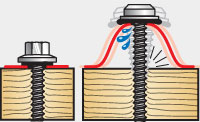 FBi uses a stainless steel capped, self-sealing screw. The screw fasteners encapsulate the sealing washer to protect it from the elements and to improve aesthetics.
FBi uses a stainless steel capped, self-sealing screw. The screw fasteners encapsulate the sealing washer to protect it from the elements and to improve aesthetics.
The washer maintains its seal and is more reliable than commonly used neoprene, and offers the best heat, cold, weather, and ozone resistance.
Wick Buildings
All Wick exterior steel is screwed down with color-matched screws, no nails. This reduces nail pops and maintenance while increasing strength against weather elements like snow and wind.
Who has the best screws?
FBi is the better choice for screws because the screws that they use are stainless steel. The head of the screw is formed to “umbrella” the washer to protect it from the elements and dry rot, longer. If you are worried about roof leaks, you’ll want to make sure that you have a screw that is protecting the water-sealing washer. FBi’s stainless steel head is guaranteed to never rust.
Since Wick uses galvanized screws, they will have a tendency to rust and corrode over time.

Trusses
FBi Buildings
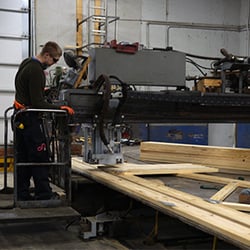 FBi trusses are made in their own plant and engineered specifically for your building. Their truss plant is also certified by a third party Truss Plate Institute inspection service to ensure the quality fabrication of all trusses.
FBi trusses are made in their own plant and engineered specifically for your building. Their truss plant is also certified by a third party Truss Plate Institute inspection service to ensure the quality fabrication of all trusses.
The lumber used to build the trusses is joined with heavy-duty steel plates. These plates are pressed straight in and have a dense concentration of long teeth providing excellent grip on the wood.
Wick Buildings
Similar to FBi, Wick’s trusses are made in their own truss plant and engineered specifically for each building. Their trusses are also made with MSR lumber and are strength tested to ensure quality fabrication.
Who has the best trusses?
FBi wins this narrowly as they press their steel plates on their trusses instead of rolling them on. Using this technique allows FBi to be even more precise when engineering truss strength when compared to Wick rolling their truss plates on.

Paint
FBi Buildings
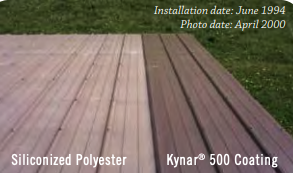 FBi’s side and roof panels are finished with the Kynar 500 Fluoropolymer paint system. This system isn’t just a wet dipped or sprayed on paint, it’s baked-on paint that has a strong resistance to fading, chalking, and corrosion.
FBi’s side and roof panels are finished with the Kynar 500 Fluoropolymer paint system. This system isn’t just a wet dipped or sprayed on paint, it’s baked-on paint that has a strong resistance to fading, chalking, and corrosion.
Developed in the 1960s, Kynar was initially produced by a single manufacturer for use on historic and monumental buildings. Their panels are known to retain their rich color for 40 years or longer.
Wick Buildings
Wick’s side and roof panels are finished with Akzo Nobel Ceram-a-Star 1050 paint. This specific paint system is a silicone-modified polyester coil coating system designed exclusively for the construction industry.
It’s highly reflective for energy efficiency and is warranted to not chip or crack for 40 years.
Who has the best paint?
Both paint systems are extremely well known in the post frame industry, but FBi gets the win for this one due to the strong resistance to fading, chalking, and corrosion of Kynar baked-on paint.

Columns
FBi Buildings
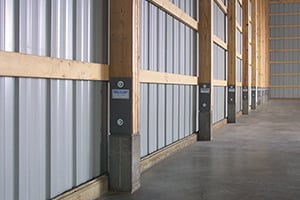 There are two types of ground contact for your columns that you can choose from when pricing your building: Laminated and Perma-Column.
There are two types of ground contact for your columns that you can choose from when pricing your building: Laminated and Perma-Column.
Similar to FBi’s trusses, they also build their laminated columns in-house. Laminated columns have greater strength in standard post frame buildings and longevity against rot than solid posts. Each layer of ground contact lumber is completely permeated with wood preservative and kiln-dried.
Not all column treatments are equal. FBi uses a .80 treatment in their columns which is 33% greater than industry standards. This treatment prevents rot and termite damage.
Alternatively, you can use Perma-Columns which are precast concrete columns. This sustainable solution is guaranteed to withstand insect damage, decay, and rotting as no wood goes into the ground.
Using 10,000 PSI precast concrete, perma-columns are 3x stronger than standard concrete. Then, the columns are reinforced with 60,000 psi rebar welded to a ¼’’ steel bracket.
Wick Buildings
Similar to Wick’s trusses, they also build their columns in-house. The columns that they construct are a standard 3-ply, 2x6 laminated column. They’re supposed to be 30% stronger in bending and 19% stronger in loading than a 6x6 solid post.
You also have the ability to upgrade your laminated columns to Perma-Columns. This is a good option for some if you’re looking to add longevity to your post frame building.
Who has the best columns?
This one comes out a tie. Both companies give you the option to choose from laminated columns or Perma-Columns, and they both manufacture their own columns.

Doors
FBi Buildings
Sliding Doors
 FBi’s EasyMotion sliding door was introduced in 2010. One of the perks that’s included with this door is the StepSaver Latch. This system saves you time and energy. No more running around to the walk-in door to disengage cam latches and snugger chains. Just turn the key and grab the handle. It’s that simple!
FBi’s EasyMotion sliding door was introduced in 2010. One of the perks that’s included with this door is the StepSaver Latch. This system saves you time and energy. No more running around to the walk-in door to disengage cam latches and snugger chains. Just turn the key and grab the handle. It’s that simple!
The EasyMotion door also features the Posi-Guide Track. This guide doesn’t collect rain, ice, snow, or debris (i.e., bird nests and leaves). A unique low-friction polymer roller is protected behind and underneath the track. This system keeps the door snug to the building as it operates.
Overhead Doors
Overhead doors are not standard with FBi’s buildings. If you want overhead doors on your building we will work directly with our preferred vendors to supply you with the style and size needed.
Our in-house engineers carefully evaluate the entire building system and will specify the necessary foundation, column, and header sizes to carry the expected loads for each door.
Wick Buildings
Sliding Doors
When comparing FBi’s sliding doors to Wick’s, you’ll notice that Wick’s sliding doors do not include a latch system. Their sliding door track is open-faced, which makes it easy to collect dirt and debris.
Overhead Doors
Unlike FBi, Wick is able to include overhead doors with their buildings. This is partially because of the dealer network that they’re involved with.
Who has the best doors?
If you’re comparing sliding doors only, then FBi gets the nod for this one with their EasyMotion Sliding Door and StepSaver latch. However, if you prefer to use overhead doors then Wick comes out on top because overhead doors are included with their buildings.
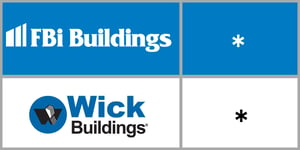
Windows
FBi Buildings
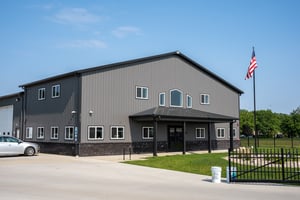 Believe it or not, there are a lot of decisions to make when choosing windows for your pole barn. The windows that we offer are energy-efficient and come in popular styles.
Believe it or not, there are a lot of decisions to make when choosing windows for your pole barn. The windows that we offer are energy-efficient and come in popular styles.
Some of your choices could include the following:
- Double-hung
- Single slider
- Eyebrow
- Half-round
- Gothic
- Full Circle
- Hexagon
- Quarter-round
Wick Buildings
Wick also offers various energy-efficient windows that come in several popular styles. Whether you’re looking for windows with grids, windows with shutters, or horizontal sliding windows...you’ll be able to choose from various sizes.
Who has the best windows?
This is a tie between FBi and Wick as they both offer windows with their buildings. We offer one piece of advice though...don’t be afraid to shop around. Sometimes, you’ll find similar windows for a cheaper price at your local hardware store.

Who has the best materials overall?
Out of the eight different material categories, FBi comes out the winner. They win three out of the eight categories, those being screws, trusses, and paint. Wick ties FBi with their steel, wood, columns, and doors. The doors category is based on personal preference. If you prefer sliding doors, then FBi comes out on top. However, if you want overhead doors, then Wick would be the better choice for you because they offer them with their buildings.
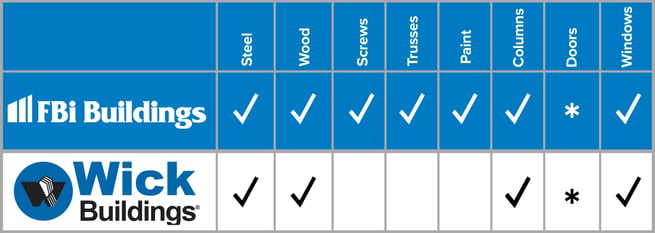
4. Delivery
FBi Buildings
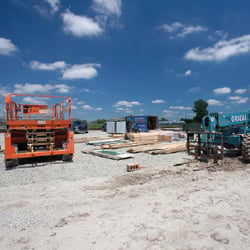 The same day that your construction starts, your material will be delivered on-site. FBi doesn’t prefer to deliver your materials to your site and have them sit out in the elements until the crew shows up. Depending on the size of your project will also determine the size and type of equipment that will be showing up.
The same day that your construction starts, your material will be delivered on-site. FBi doesn’t prefer to deliver your materials to your site and have them sit out in the elements until the crew shows up. Depending on the size of your project will also determine the size and type of equipment that will be showing up.
FBi normally brings the following equipment to a job site:
- A semi for material and delivery
- Gradall / telehandler
- Crew truck and trailer
- Skid-steer. if applicable
- And a crane, if applicable
Their materials are delivered with company-employed drivers straight from their own lumber yards.
Wick Buildings
Unlike FBi, Wick’s deliveries are dropped off on-site prior to their crews showing up. Wick’s materials are delivered on company trucks and unloaded by their drivers. Prior to the materials being delivered, the purchaser is responsible for providing adequate room for the semi-truck and crew to access their building site.
Who has the best delivery?
Wick needs to be recognized for its wide range of delivery (due to their larger brand), but FBi offers a more personalized and comprehensive approach to delivery. Their materials are on site the same day that construction starts.

5. Construction
FBi Buildings
 The quality of the construction crew is a major factor in building your pole barn. Experienced men make fewer mistakes, giving you a higher quality building.
The quality of the construction crew is a major factor in building your pole barn. Experienced men make fewer mistakes, giving you a higher quality building.
FBi Buildings crews are employees of FBi Buildings and are specifically trained in the safe construction of pole barns. FBi buildings strive to employ local individuals for crews across their expanding territory. This allows their 45+ crews to serve an area they are familiar with.
FBi Building's commitment is to provide you with excellent service from start to finish! We have a Crew Management team of construction veterans who oversee and support the foremen and his crew. In fact, our average tenure is over 17 years between our foremen and our crew management team!
Wick Buildings
Your construction crew with Wick will depend on what type of package you end up buying through them.
For example, if you go through a Wick dealer, Wick will provide the materials but the dealer’s crew will construct your building. You also have the option to purchase the building through Wick as a Wick-constructed building. If you choose to go this route, Wick’s crews will be the ones erecting your building.
Unlike FBi, Wick doesn’t offer as many construction crews. This could be a negative for some because their crews travel a lot more to get jobs done.
Who has the best construction?
Both companies provide construction crews, but the nod here goes to FBi. FBi takes this one because of their tenure experience between their crews and Crew Management teams. Having a smaller region to service has allowed FBi to maintain their crews and foreman for industry records. Wick’s mix of their own crews and crews from their dealership network can make it harder to ensure quality training and hiring.

6. Warranty
FBi Buildings
A pole barn warranty is simply a promise to stand behind a product or service. All warranties are limited, and there is no standard warranty in the post-frame industry.
Here’s what’s covered under FBi’s warranty:
- Columns: Lifetime
- Roof Structure: 20 Years
- Red Rust: 15 Years
- Paint: 40 Years
- Gloss Loss: 5 Years
- Roof Leaks: 5 Years
- Sliding Doors: Lifetime
- Workmanship: 1 Year
Wick Buildings
Wick offers two types of warranties for their buildings, one for Wick-constructed projects and one for Wick material packages.
Wick’s Construction Services Warranty:
- Columns: 50 Years
- Paint: 40 Years
- Chalking: 30 Years
- Steel Panels Exposed to Normal Weather: 20 Years
- Roof Leaks: 7 Years
- Structural Framework (including Sliding Doors): 5 Years
- Workmanship: 1 Year
Wick’s Material Packages Warranty:
- Columns: 50 Years
- Paint: 40 Years
- Chalking: 30 Years
- Steel Panels Exposed to Normal Weather: 20 Years
- Roof Structure: 5 Years
- Hail Damage: 5 Years
Who has the best warranty?
This one is a tie between FBi and Wick. While both companies cover different parts of the building, Wick also offers a material package warranty (which might be a selling point for some buyers). While FBi's columns and sliding doors are a lifetime warranty, Wick's warranty covers chalking and steel panels exposed to normal weather. FBi's warranty also covers red rust and gloss loss, which is not covered by Wick's warranty.

7. Cost
FBi Buildings
FBi is well aware that they aren’t the cheapest post frame builder out there, but they also aren’t the most expensive.
A standard pole-building shell can cost anywhere from $20 to $60 per square foot. Now, you’re probably asking yourself, “Why is there a big difference in price per square foot?”
Here’s why...
The following factors will determine if your pole barn is leaning toward the low/high side of the cost spectrum:
- Total square feet
- Type of features (e.g., overhangs, windows, walk-in doors, steel liner packages, etc.)
- Current nature of the commodities market (the price of steel)
For example, adding a porch, cupolas, and numerous doors will push you closer to the $45 per square foot, depending on the size of the building.
Wick Buildings
When it comes to cost, FBi can be higher or lower than Wick. The price is usually factored by what dealer is putting up Wick’s buildings.
When Wick is higher, their final price will include turnkey construction. Your price will also fluctuate depending on what dealer constructs your building. Because of that, it’s more difficult to provide a price per square foot.
Who has the best cost?
When removing all factors that go into cost and looking at the raw cost between the two companies, FBi will typically win this battle. However, if you’re looking for turnkey construction, then Wick might be the better option for you.

Who’s Best for Your Post Frame Building Project?
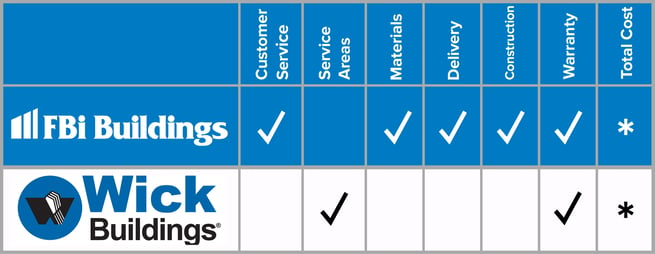
NOTE: The star denotes personal preference based on the buyer. Please reference each section for specifics.
Every builder has their advantages and disadvantages, and the final decision is solely up to you and your specific needs.
- Wick Buildings is the way to go if you’re looking for a one-stop-shop builder. This is important to some if you don’t want the hassle of trying to find subcontractors for concrete and electric work.
- FBi Buildings is the right choice if you’re looking to make a long-lasting investment and would like to get a more personalized sales experience.
If you’re still unsure about what to do, we recommend checking out these additional resources:
- FBi Buildings vs Menards: Who’s Best for Your Project?
- FBi Buildings vs Cleary: Who’s Best for Your Project?
- FBi Buildings vs Morton: Who’s Best for Your Project?
- 7 Questions to Ask Your Pole Barn Builder
- Pole Building Prices: 6 Considerations for Comparing
- What is Site Preparation? 7 Tips to Get You Started
We’d be happy to work with you on your pole barn project if you’re located in Indiana, Illinois, Iowa,, Michigan, Missouri, or Ohio.
Do you have more questions that are not covered in this article? If you need help designing and planning, please contact FBi Buildings at 800.552.2981 or click here to email us. If you are ready to get a price, click here to request a quote and a member of our customer engagement team will help you determine the next steps of your project
